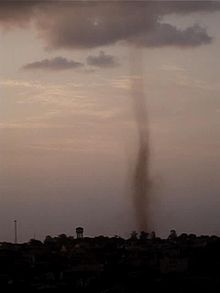Landspout



| Part ofa serieson |
| Weather |
|---|
|
|
Landspoutis a term created by atmospheric scientistHoward B. Bluesteinin 1985 for atornadonot associated with amesocyclone.[3]TheGlossary of Meteorologydefines a landspout:
- "Colloquial expression describing tornadoes occurring with a parentcloudin its growth stage and with itsvorticityoriginating in theboundary layer.
- The parent cloud does not contain a preexisting mid-level mesocyclone. The landspout was so named because it looks like "a weakFlorida Keyswaterspoutover land. "[4]
Landspouts are typically weaker than mesocyclone-associated tornadoes spawned withinsupercellthunderstorms, in which the strongest tornadoes form.
Characteristics
[edit]Landspouts are a type of tornado that forms during the growth stage of acumulus congestusor occasionally acumulonimbuscloud when anupdraftstretches boundary layer vorticity upward into a vertical axis and tightens it into a strongvortex.Landspouts can also occur due to interactions fromoutflow boundaries,as they can occasionally cause enhanced convergence and vorticity at the surface. These generally are smaller and weaker than supercell tornadoes and do not form from a mesocyclone or pre-existing rotation in the cloud. Because of this lower depth, smaller size, and weaker intensity, landspouts are rarely detected byDoppler weather radar(NWS).[5]
Landspouts share a strong resemblance and development process to that of waterspouts, usually taking the form of a translucent and highlylaminarhelical tube. "They are typically narrow, rope-likecondensationfunnels that form while the thunderstorm cloud is still growing and there is no rotating updraft ", according to theNational Weather Service.[2]Landspouts are considered tornadoes since a rapidly rotating column of air is in contact with both the surface and acumuliform cloud.Not all landspouts are visible, and many are first sighted as debris swirling at the surface before eventually filling in with condensation and dust.
Orographycan influence landspout (and even mesocyclone tornado) formation. A notable example is the propensity for landspout occurrence in theDenver Convergence Vorticity Zone(DCVZ).
Life cycle
[edit]Forming in relation tomesocyclonesand under updrafts, a landspout generally lasts for less than 15 minutes; however, they can persist substantially longer, and produce significant damage. Landspouts tend to progress through recognizable stages of formation, maturation, and dissipation, and usually decay when adowndraftor significantprecipitation(outflow) occur nearby. They may form in lines or groups of multiple landspouts.[6]
Damage
[edit]Landspouts are commonly weak; however, on rare occasions, a landspout can be as strong as anEF2orEF3tornado.
See also
[edit]References
[edit]- ^Judson Jones (21 May 2020)."Why Landspout Tornadoes are Common in Colorado".The Denver Post.
- ^abJudson Jones (8 June 2021)."The No. 1 US county for producing tornadoes just spawned another landspout".CNN.
- ^Bluestein, Howard B. (1985)."A History of Severe-Storm-Intercept Field Programs".Weather and Forecasting.14(4): 267–270.Bibcode:1999WtFor..14..558B.doi:10.1175/1520-0434(1999)014<0558:AHOSSI>2.0.CO;2.ISSN1520-0434.
- ^American Meteorological Society (2000)."Glossary of Meteorology, Second Edition".ametsoc.org.Archived fromthe originalon 6 April 2007.Retrieved27 March2007.
- ^Wakimoto; Wilson (1989)."Non-supercell Tornadoes".Monthly Weather Review.117(6): 1113–1140.Bibcode:1989MWRv..117.1113W.doi:10.1175/1520-0493(1989)117<1113:NST>2.0.CO;2.
- ^Forbes; Wakimoto (1983)."A Concentrated Outbreak of Tornadoes, Downbursts and Microbursts, and Implications Regarding Vortex Classification".Monthly Weather Review.111(1): 220–235.Bibcode:1983MWRv..111..220F.doi:10.1175/1520-0493(1983)111<0220:ACOOTD>2.0.CO;2.
External links
[edit] Media related toLandspoutsat Wikimedia Commons
Media related toLandspoutsat Wikimedia Commons- Advanced Spotters' Field Guide
- Online Tornado FAQ

